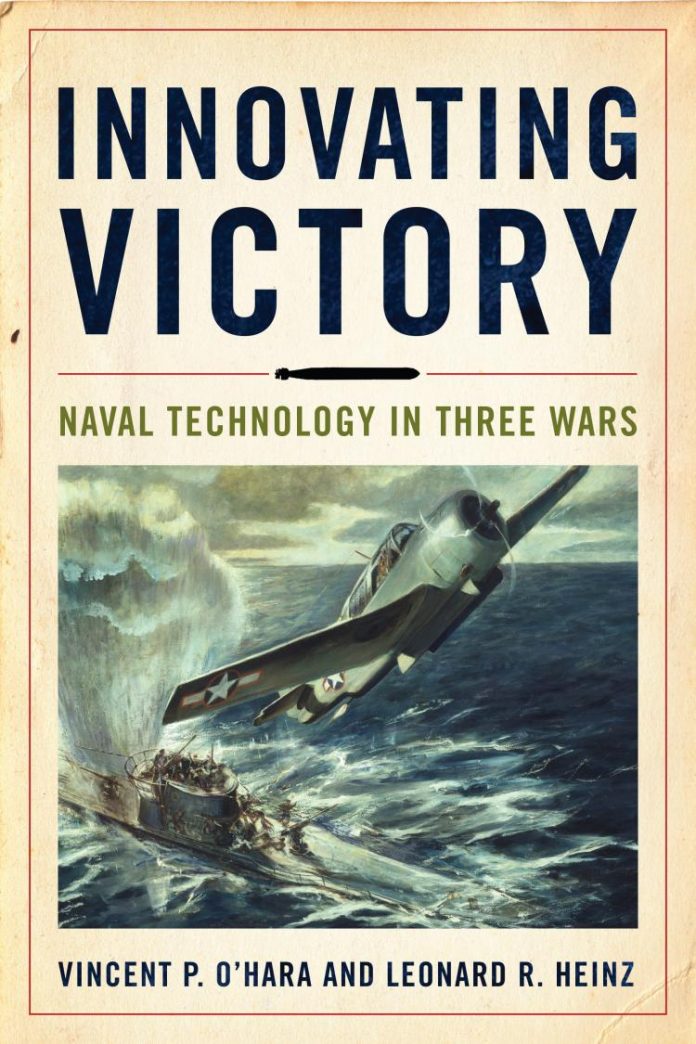
Innovating Victory – Naval Technology in Three Wars. By Vincent P. O’Hara and Leonard R. Heinz. Naval Institute Press, Annapolis, Maryland, 2022.
Reviewed by John Mortimer
This book looks at how selected world navies incorporated certain technologies into their ships, operations and doctrine. It examines six core technologies which were fundamental to twentieth century naval warfare. The technologies examined in detail are: mines, torpedoes, radio, radar, submarines and aircraft.
Each chapter discusses when and where the technologies were first developed, when it was used in war and what navies expected of it. It also traces the evolution of each technology and how it was eventually used compared to navies original intentions. Development of the technology in different navies is examined as is its employment in time of conflict, mainly during the Russo-Japanese War, World War 1 and World War 2.
Whilst discussing some post World War 2 technological developments the authors generally avoid assessments arguing that the technologies have not been tested in major power conflict in more recent years, and hence accurate data is not available to sustain valid assessments. Having made these observations the authors nevertheless do make some broad statements on current capabilities. In relation to submarines, it is concluded that: “There is reason to think that they would be even more effective now, given the relative states of submarine and ASW technology.” In relation to the torpedo, the authors conclude that: “It is likely to be a part of naval arsenals for years to come and to experience more permutations before the concept is finally obsolete.” In relation to naval aviation the authors conclude that: “It is difficult to know whether the carrier has had its day, but the current crop of antiship weapons give little cause for optimism. Navies will still require wings, but those wings may well prove to be of a new type (such as unmanned drones) flying from new platforms rather than large, expensive aircraft flying from large, expensive ships.”
A goal of this book was to set forth the principles that govern the successful development, introduction and use of naval technology. It concludes in this context that:
Expectations do not determine best use. Historically, the expectations that attend new technologies have been unrealistic, and uses the development of submarines and aircraft as examples – their capabilities took a long time to mature.
Users have valuable input. Scientists and experts in general, believe that they know best and have a poor record of accepting user contributions. For a long time complaints from submarine and destroyers crews about torpedo performance were ignored, epecially in the US and German navies.
Needs influence use. Different navies use identical technologies differently. The difference between Allied and German development of radar is a prime example of this.
New technologies bring new vulnerabilities. Radar and Active sonar emit sound waves that can detect and be detected by the enemy. Computer based systems whilst bringing efficiencies in operations, also expose users to increasing levels of vulnerability.
Overall, the book provides useful insights from its analysis and discussion of key tecnological developments during the first half of the 20th century. It also provides some stimulus for consideration by those planning the future of navies, in an inceasingly complex and challenging world. One of the key messages from the book is the need for a combination of scientists and specialists to work in collaboration with the end users to ensure a successful and effective outcome.
When considering the title of the book I had expected some discussion of how innovation in certain countries resulted in victory in the wars considered. The authors approach to confine its analysis to six specific naval technologies meant that this broader issue was not adequately addressed.
While technology obviously played an important part in the outcome of the First and Second World wars the outcome was largely determined by the significantly greater industrial capacities of the US and British empire, together with their better access to resources in the form of finances, people and raw materials. In the Second World War the early advances by both the German and Japanese forces also meant that a large proportion of their military assets were diverted to maintain control of captured territory, and were not necessarily available for offensive operations. Also their more limited industrial capcity meant that losses could not be readily provided to sustain operations. The situation of the Imperial Japanese Navy after the Battle of Midway is illustrative of this. The matter of reducing and narrowing industrial capacity is particularly concerning at present for western democracies.



